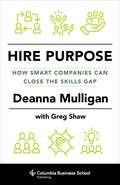- Table View
- List View
Hilti Fleet Management (A): Turning a Successful Business Model on Its Head
by Ramon Casadesus-Masanell Oliver Gassmann Roman SauerThis case explores the introduction of fleet management in the construction industry by the premium power tools manufacturer Hilti in 2000. Following its customers' needs, Hilti moved from selling power tools to leasing them as a service. The introduction of the new business model contributed significantly to the success of Hilti, since it sustainably differentiated the company from its competitors. For instance, the adoption of fleet management resulted in customer loyalty levels five times higher than under the dominant business model Hilti had formerly employed, and over-proportioned profit contribution at Hilti. Hilti's Chief Technology Officer described the importance of the innovation as follows: "Hilti developed many very innovative and successful products over the years, but they paled in comparison with the fleet management business model, which was the most important innovation in Hilti's history." All told, Hilti, which had about 22,000 employees and made about 4.5 billion Swiss Francs (or $4.589 billion USD) in sales in 2015, managed 1.5 million tools under fleet management contracts in 40 countries, resulting in a contract value of more than 1.2 billion Swiss Francs (approximately $1.4 billion USD). Case A describes the strategic decision-making process regarding the introduction of fleet management in its early planning stages. Case B (separate) tackles the implementation and scaling process of fleet management over the years and explores current challenges facing the BMI.
Hilti Fleet Management (A): Turning a Successful Business Model on Its Head
by Ramon Casadesus-Masanell Oliver Gassmann Roman SauerThis case explores the introduction of fleet management in the construction industry by the premium power tools manufacturer Hilti in 2000. Following its customers' needs, Hilti moved from selling power tools to leasing them as a service. The introduction of the new business model contributed significantly to the success of Hilti, since it sustainably differentiated the company from its competitors. For instance, the adoption of fleet management resulted in customer loyalty levels five times higher than under the dominant business model Hilti had formerly employed, and over-proportioned profit contribution at Hilti. Hilti's Chief Technology Officer described the importance of the innovation as follows: "Hilti developed many very innovative and successful products over the years, but they paled in comparison with the fleet management business model, which was the most important innovation in Hilti's history." All told, Hilti, which had about 22,000 employees and made about 4.5 billion Swiss Francs (or $4.589 billion USD) in sales in 2015, managed 1.5 million tools under fleet management contracts in 40 countries, resulting in a contract value of more than 1.2 billion Swiss Francs (approximately $1.4 billion USD). Case A describes the strategic decision-making process regarding the introduction of fleet management in its early planning stages. Case B (separate) tackles the implementation and scaling process of fleet management over the years and explores current challenges facing the BMI.
Hilti Fleet Management (B): Towards a New Business Model
by Ramon Casadesus-Masanell Oliver Gassmann Roman SauerThe (B) case tackles the implementation and scaling process of fleet management over the years. Finally, the case explores current challenges facing the BMI.
Hilti Fleet Management (B): Towards a New Business Model
by Ramon Casadesus-Masanell Oliver Gassmann Roman SauerThe (B) case tackles the implementation and scaling process of fleet management over the years. Finally, the case explores current challenges facing the BMI.
Hilton HHonors Worldwide: Loyalty Wars
by John Deighton Stowe ShoemakerHilton Hotels regards the frequent guest program as the industry's most important marketing tool, directing marketing efforts at the heavy user. What is Hilton to do then, when a competitor ups the ante? This case illustrates the economics of frequency marketing in industries with a very distinct "heavy half" to their customer base, and lets students debate what to do when Sheraton and Westin seemingly overdo a good thing.
Hilton Hotels: Brand Differentiation through Customer Relationship Management
by Chekitan S. Dev Lynda M. Applegate Gabriele PiccoliThis case analyzes the Hilton Hotels Corporation's CRM strategy at a key juncture in its history, immediately after the firm has been taken private by Blackstone. The case provides students with a comprehensive history of the evolution and IT enablers of Hilton's CRM Initiative, as well as the proprietary OnQ enterprise system. The case thus offers a rare opportunity to engage in a longitudinal evaluation of the firm's CRM initiative, and to enable students to propose the future evolution of the initiative based on their analysis.
Hilton Manufacturing Co.
by William J. Bruns Jr.A professional manager is hired by a small manufacturing company after the president discovers he made poor decisions. One product appears to be unprofitable, whereas the product sold in highest volume is under competitive price pressure. A crude cost accounting system fails to reveal appropriate actions to correct problems.
Himscorp, Inc.
by William A. Sahlman Michael J. Roberts Laurence E. KatzHimscorp is an industry consolidation of records storage companies providing management and retrieval services of active medical records to healthcare institutions. Kent Dauten, a former general partner at Madison Dearborn Partners with 15 years of venture capital and buyout experience, has personally sponsored the industry consolidation and is considering whether to invest in growth, sell to a strategic buyer, or pursue an initial public offering. This case presents an opportunity to discuss the process of a roll-up and the sources of value creation.
Hindalco: Globalizing Through a Transformational Merger--A Profile of One of India's Pioneering Multinationals
by Nirmalya Kumar Pradipta K. Mohapatra Suj ChandrasekharThe story behind Hindalco's $6 billion acquisition of Novelis is of particular interest because of the firm's boldness. When Hindalco made the bid in 2007, Novelis represented the largest Indian investment in North America and the second-largest overseas investment by an Indian company, behind Tata's purchase of Corus just two weeks earlier. Would this bold move prove an effective way for Hindalco to go global and ensure long-term profitability by merging downstream and upstream operations? This chapter provides a detailed account of how Hindalco became a global Fortune 500 company through its transformational acquisition. This chapter is excerpted from "India's Global Powerhouses: How They Are Taking on the World."
Hindustan Petroleum Corporation Ltd.: Driving Change Through Internal Communication
by Boris Groysberg Michael SlindHindustan Petroleum (HPCL), confronted in 2003 with an urgent need to change how it operated externally, adopted a highly innovative approach to communicating internally. This case, set in 2010, presents an overview of the new, more interactive model of employee communication that HPCL introduced as part of its effort to adapt to increased market competition during the early 21st century. (HPCL, previously a wholly state-owned company within a state-controlled industry, had begun to operate in an increasingly privatized environment.) At the center of the new model was a series of "vision workshops"--structured conversations in which employees at all levels of the company took part in developing strategic and organizational visions for their regional offices, for their business units, and for the company as a whole. The case also discusses HPCL's use of digital technology to enhance employee communication; its leaders' increased emphasis on direct, "one-to-one" interaction with employees; and some of the consequences (both external and internal) of this more conversational model of organizational communication. As of 2010, HPCL was a Fortune Global 500 company, with more than 11,000 employees and with annual revenues of more than $23 billion. The question that company leaders now faced was whether HPCL's novel approaches to communicating with employees were appropriate to its next stage of internal development and external growth.
Hindustan Unilever Limited
by Thomas J. Delong Mona SinhaThis case illustrates HUL's conflict resolution and people development policies using a 'Leading from the middle' example. The story centers around the challenges faced by an HR manager at a factory who must meet organizational objectives, while handling multiple trade unions that are resisting change as well as having conflicts amongst themselves.
Hindustan Unilever's "Pureit" Water Purifier
by V. Kasturi Rangan Mona SinhaThe case asks students to formulate a strategy to respond to various competitive threats to its Pureit Water purifier, launched in 2008, targeted at millions of low-income Indian consumers who did not have access to safe drinking water. The case describes in detail the product development and launch process that required HUL, the $3.5 billion Indian subsidiary, to innovate on many different fronts. It details competitive actions since the launch to set the stage for what the company should do next.
Hindustan Unilever's 'Pureit' Water Purifier
by V. Kasturi Rangan Mona SinhaThe case asks students to formulate a strategy to respond to various competitive threats to its Pureit Water purifier, launched in 2008, targeted at millions of low-income Indian consumers who did not have access to safe drinking water. The case describes in detail the product development and launch process that required HUL, the $3.5 billion Indian subsidiary, to innovate on many different fronts. It details competitive actions since the launch to set the stage for what the company should do next.
Hines Goes to Rio
by Arthur I SegelThe Torre Almirante office tower, Hines' newest project in Rio de Janeiro, was a 36-story, Class AA office tower with an adjoining 420-stall parking structure and a preserved 14-story historic facade. It was completely different from anything that had previously been built in the city. It was also the first time that a developer took the risk of publicly announcing to the Brazilian business community its intention and commitment to complete such a complex real estate project on schedule. It was an impressive and unprecedented enterprise, but at this stage, the project was enmeshed in some operational complications. Several project designs were not yet ready, and discussions among the different companies involved in the development had intensified in the past weeks. Robert A.M. Stern Architects, the New York-based design architect, was debating with Hines about issues ranging from the glass window specifications to the material for the gold leaf lobby ceiling. Pontual Arquitetura, the local production architect, was concerned about the fire protection system. In addition, Racional, the local general contractor, just pointed out a serious problem in the freight elevator shaft that could force Hines to modify substantial parts of the project and, consequently, trigger a new round of required approvals. Includes color exhibits.
Hinter den Nachrichtenbildern: Warum wir unseren Augen nicht (immer) trauen können
by Michael Wegener Mirco LiefkeNachrichtenbilder prägen unsere Vorstellung der Wirklichkeit – doch wie entstehen sie? Dieses Buch nimmt die Stärken und Schwächen des globalen Nachrichtenjournalismus unter die Lupe und geht Fragen nach, die in unserer Informationsgesellschaft von entscheidender Bedeutung sind: Warum sehen wir aus manchen Regionen dieser Welt immer dieselben Nachrichtenbilder - und aus anderen gar keine? Wie arbeiten die großen Bildnachrichtenagenturen und wie bestimmen sie so die Bilder in Sendungen wie „Tagesschau“ und „heute-Nachrichten“? Wie wird in den Redaktionen entschieden, welche Bilder gesendet werden und wie wird geprüft, ob diese auch wirklich authentisch sind? Fragen wie diese beantworten die Autoren vor dem Hintergrund bekannter und weniger bekannter Nachrichtengeschichten. Auf anschauliche und zugleich theoretisch reflektierende Weise vermitteln sie, wie Redaktionen tagtäglich auf Wahrheitssuche gehen und zeigen auf, wie wirtschaftliche und politische Zwänge unser Bild der Welt trüben können.
Hinterland Dreams: The Political Economy of a Midwestern City (American Business, Politics, and Society)
by Eric J. MorserIn the 1840s, La Crosse, Wisconsin, was barely more than a trading post nestled on the banks of the Mississippi River. But by 1900 the sleepy frontier town had become a thriving city. Hinterland Dreams tracks the growth of this community and shows that government institutions and policies were as important as landscapes and urban boosters in determining the small Midwestern city's success. The businessmen and -women of La Crosse worked hard to attract government support during the nineteenth century. Federal, state, and municipal officials passed laws, issued rulings, provided resources, vested aldermen with financial and regulatory power, and created a lasting legal foundation that transformed the city and its economy. As historian Eric J. Morser demonstrates, the development of La Crosse and other small cities linked rural people to the wider world and provided large cities like Chicago with the lumber and other raw materials needed to grow even larger. He emphasizes the role of these municipalities, as well as their relationship to all levels of government, in the life of an industrializing nation.Punctuated with intriguing portraits of La Crosse's early citizens, Hinterland Dreams suggests a new way to understand the Midwest's urban past, one that has its roots in the small but vibrant cities that dotted the landscape. By mapping the richly textured political economy of La Crosse before 1900, the book highlights how the American state provided hinterland Midwesterners with potent tools to build cities and help define their region's history in profound and lasting ways.
Hintz-Kessels-Kohl A.G.
by Thomas R. Piper Max DonnerA truck manufacturer must decide whether to bid on the sale of 120 trucks to a private firm in Costa Rica. If a bid is submitted, a decision must be made on whether to protect against the credit, exchange rate, and sovereign risks.
Hiphop-Marketing: Hiphop-Kultur verstehen und authentische Marken gestalten
by Jonas Polfuß Ismail BoulaghmalDieses Buch bietet einen umfassenden Einblick in die Hiphop-Kultur und zeigt, wie erfolgreiches Hiphop-Marketing gelingt. Hiphop hat sich in den letzten 40 Jahren zu einem globalen Musik-, Sozial- und Konsumphänomen entwickelt, das im Marketing gewinnbringend genutzt werden kann. Doch Hiphop-Marketing befindet sich noch am Anfang und scheitert meist an fehlender Expertise. Die Autoren vermitteln sorgfältig recherchierte Informationen über die komplexe Hiphop-Kultur und leuchten die Entwicklungsmöglichkeiten von Marketing und Geschäftsfeldern mit Hiphop-Bezügen aus. Sie bieten konkrete Handlungsempfehlungen für erfolgreiche Hiphop-Kampagnen, -Kooperationen und -Sponsorings und illustrieren dies an aktuellen Beispielen aus dem Bereich urbaner, sportiver sowie luxuriöser Marken. Dabei liegt der Fokus auf der Gestaltung einer authentischen Kommunikation, die nur durch ein tiefes Verständnis der Zielgruppe zu erreichen ist. Ein Buch für Marketing-Experten und Unternehmen, die ihre Markenkommunikation zielgruppenadäquat und überzeugend gestalten wollen. Aus dem Inhalt • Kulturelle Hintergründe der Hiphop-Entstehung• Hiphop-Geschichte in Deutschland und den USA• Dynamik zwischen Subkultur und Kommerzialisierung• Deutsches und amerikanisches Hiphop-Marketing • Kooperationen, Kampagnen und Sponsorings für eine authentische Hiphop-Marke
Hire Purchase Under Shirkah al-Milk (HPSM) in Islamic Banking and Finance: A Shari'ah Analysis
by M. Kabir Hassan Aishath Muneeza Muhammad Mostofa HossainHPSM is a modern financial contract that comprises shirkah (partnership), ijarah (lease), and sale contracts. In the HPSM contract, ownership of the asset is jointly held by the bank and the client. The client makes regular instalments. During the contract, the client is granted to use the asset as long as he meets specific conditions. Upon the completion of all instalments, the asset becomes the property of the client. This book seeks to shed light on the fundamental concept of HPSM, including the policies, regulations, and subsidiary contracts that play a vital role in its practical application. It provides a thorough exploration of the documentation and accounting procedures, while also addressing potential Shari’ah-related issues in HPSM, and will be of potential interest to students, researchers, policymakers and practitioners, offering a comprehensive understanding of how HPSM is applied within the Islamic finance industry.
Hire Purpose: How Smart Companies Can Close the Skills Gap
by Greg Shaw Deanna MulliganThe future of work is already here, and what this future looks like must be a pressing concern for the current generation of leaders in both the private and public sectors. In the next ten to fifteen years, rapid change in a post-pandemic world and emerging technology will revolutionize nearly every job, eliminate some, and create new forms of work that we have yet to imagine. How can we survive and thrive in the face of such drastic change?Deanna Mulligan offers a practical, broad-minded look at the effects of workplace evolution and automation and why the private sector needs to lead the charge in shaping a values-based response. With a focus on the power of education, Mulligan proposes that the solutions to workforce upheaval lie in reskilling and retraining for individuals and companies adapting to rapid change. By creating lifelong learning opportunities that break down boundaries between the classroom and the workplace, businesses can foster personal and career well-being and growth for their employees. Drawing on her own experiences, historical examples, and reports from the frontiers where these issues are unfolding, Mulligan details how business leaders can prepare for and respond to technological disruption. Providing a framework for concrete and meaningful action, Hire Purpose is an essential read about the transformations that will shape the next decade and beyond.





